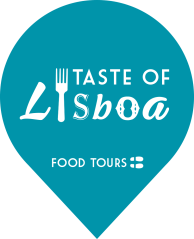Portuguese foods inherited from the Moorish occupation
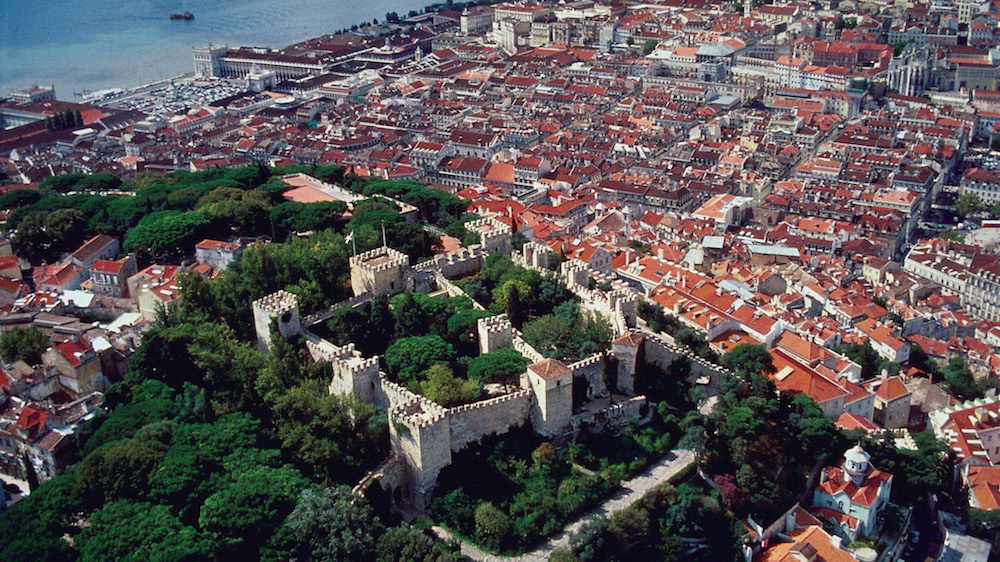
Portugal’s culinary identity is full of references to Arabic cuisine. The presence of the Moors (the Muslim inhabitants of the Maghreb) in the Iberian Peninsula, between the 8th and the 14th centuries, influenced the way we live and eat in Portugal until today.
You see this muslism influence from Northern Africa in the aesthetics of Lisbon, for example, where building facades are still decorated with tiled walls. When it comes to the name of our neighborhoods and regions, you’d know that any word starting with al comes from those days too, as al means the in Arabic. The popular Lisbon neighborhood of Alfama, for example, was named “the baths” after the water sources that once upon a time existed in that part of the city.
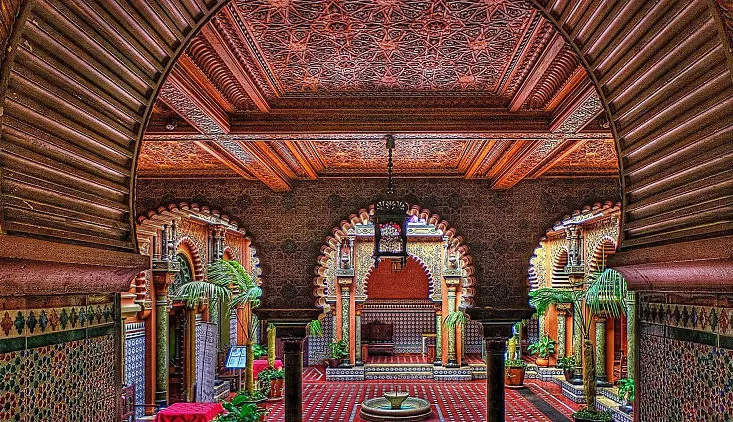
When it comes to food, there are many dishes and cooking methods considered traditional in Portugal that are an evolution of preparations that were already present in the Maghreb region where the new settlers of Portugal came from in the 8th century. We’re talking about food preservation methods such as salting, smoking and pickling.
Regarding recipes, this influence is palpable mostly in the form of soups and stews, with notable examples particularly towards the south of Portugal, in the Alentejo and Algarve regions, but that extends even to the Portuguese islands of the Azores!
These are the most notable examples of Moorish influenced foods we eat in Portugal today:
Açorda
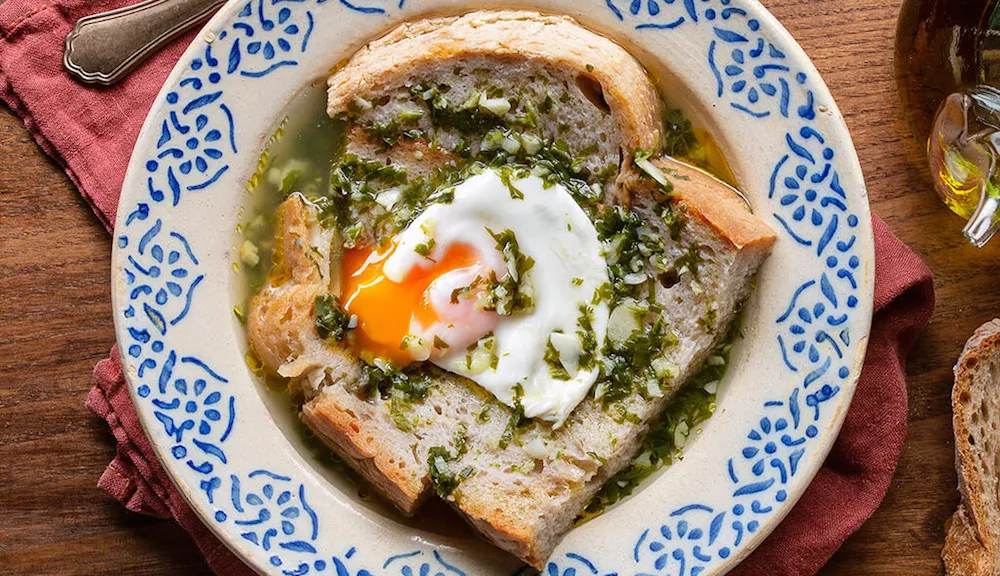
This typical soup from the Alentejo is an example of rural fare that was inherited from centuries ago, when the Moors were already keen on preparing food in simple ways that would highlight seasonal vegetables and preserve their nutritional value after cooking.
Açorda consists of a serving of a thick slice of bread drowned in broth with garlic and herbs such as cilantro or pennyroyal, most often than not topped with a poached egg. Fish, such as cod and dogfish, can also make an appearance on açorda, but not necessarily.
In the Arabic cuisine book Kitâb-al-tabîj, from around the 10th century, we can find the first reference to açorda, in this case with the designation tarid which in Arabic means mashed bread with hot water. Even etymologically, there’s no denying the origins of açorda, once ath thurdâ in Arabic means soaked bread, which is literally what açorda is.
Cataplana
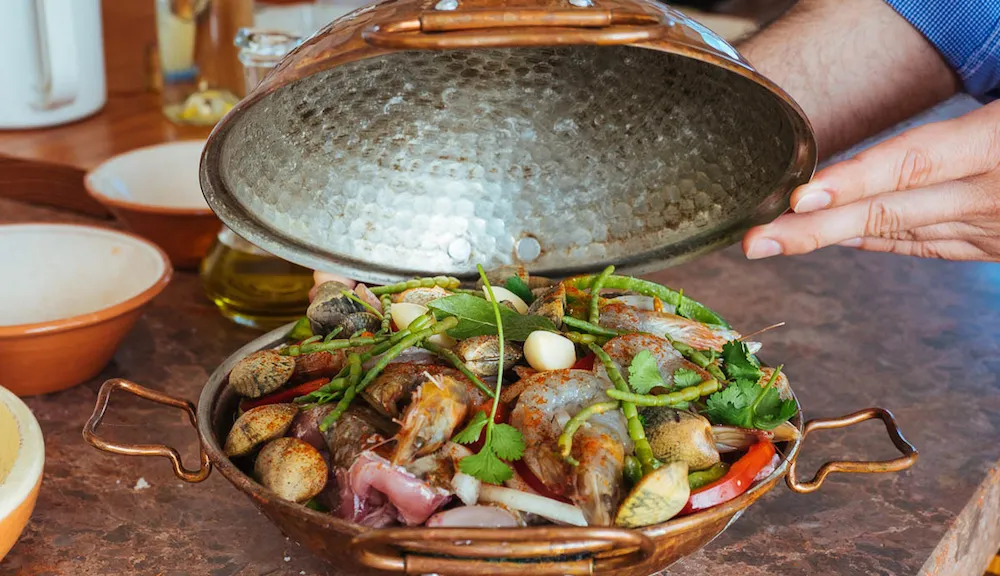
Cataplana is both a metal clamshell cooking plate and the name of the recipe prepared inside this cooking vessel. In fact, this is one of the Algarve’s most popular dishes! This aluminum cookware item consists of a clamshell that can be sealed using a clamp on the sides of the pot. This way, the ingredients put inside the cataplana are cooked in their own steam and juices, retaining not only all the flavor but also potentiating the nutritional value.
Internationally, the cataplana is sometimes referred to as the Portuguese tajine, focusing on its similarity with the popular vessel and dish from Morocco. Even though traditionally tajines are made out of clay, they do use the same kind of airtight steaming cooking process as a cataplana. In both cases, the dishes are cooked slowly with low temperatures.
Cuscos
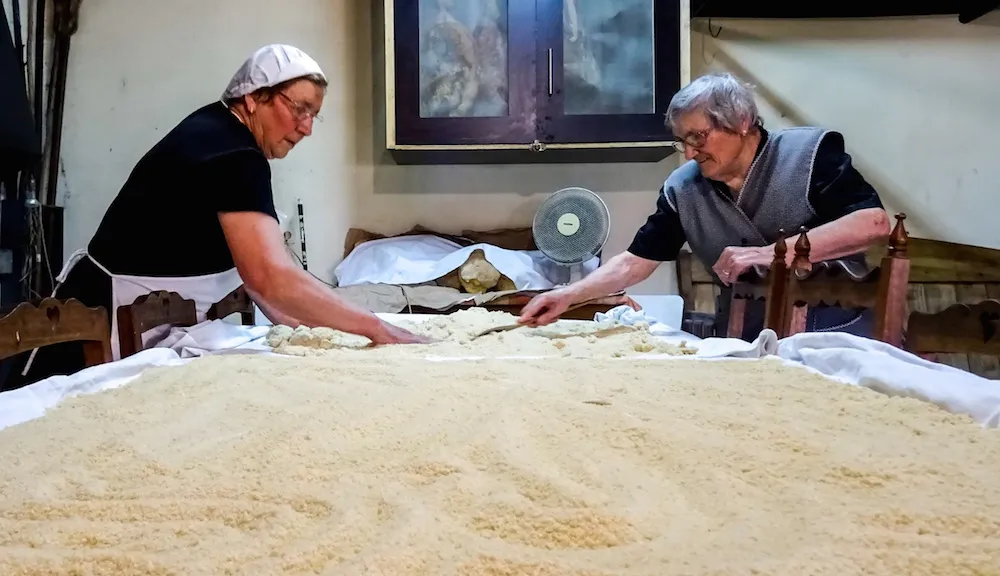
Even if you go all the way north in Portugal, to the region of Trás-os-Montes, you can still feel the Arabic influence. Here you will encounter cuscos, also known in english as couscous, as part of the regional diet, even though not as popular as decades ago.
Typically made using a local variety of wheat by the name of Barbela, these labor intensive little nuggets of grain are a very obvious Portuguese cousin of the Maghebrian couscous. Transforming wheat into tiny cuscos flakes was a way to preserve the cereal for the duration of the year, as the cuscos are pre-cooked thus making them much more long lasting.
It’s interesting to see how cuscos became a staple in Trás-os-Montes, a region where the Moors didn’t actually make it to. Yet it is believed that it was actually the Jews, who carried a lot of the traditions of the Maghreb and Andaluzia, that imported the couscous and other habits into this northern region, while seeking refuge from religious persecution in this more secluded mountainous area of Portugal.
Cuscos in Trás-os-Montes are typically prepared almost like a risotto, in rather saucy preparations with greens or mushrooms. They can be used as a side dish for meat and fish dishes or also to bulk up soups and even desserts!
Escabeche
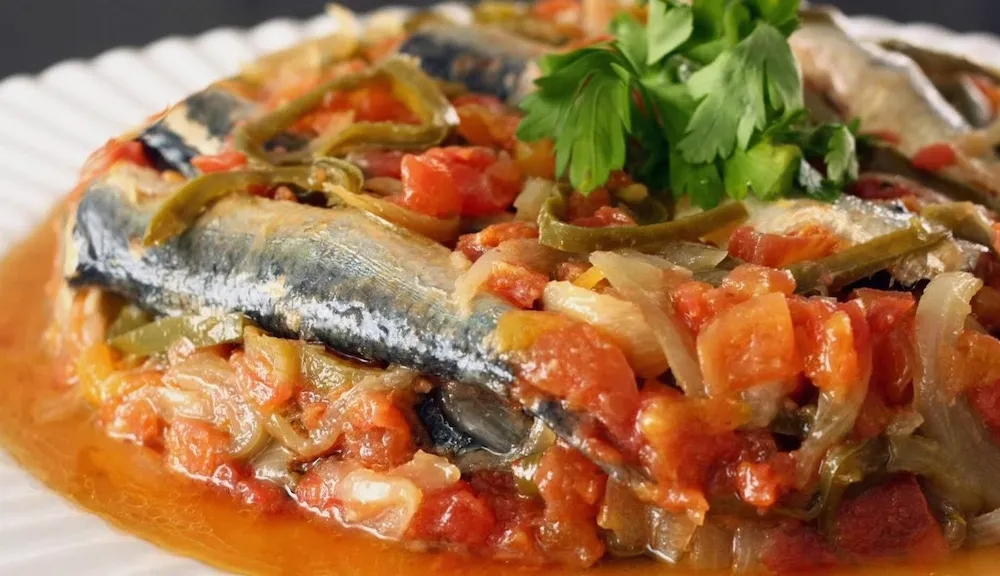
This is a typical sauce common in both Portugal and Spain, which was inherited from the times of the muslim ocupation in the Iberian Peninsula. Escabeche derives from al-sikbaj, a sweet and sour sauce with vinegar and honey.
Being heavy on vinegar, escabeche sauce is applied to fish like sardines or mackerel, not only to affect the flavor and texture of the fish, but also as a way to preserve the fish for longer. Apart from vinegar, the other basic ingredients that go into making escabeche are thinly sliced onions, garlic, bay leaf, tomatoes and olive oil. In fact, even the widespread use of olive oil in Portugal dates back to the muslim ocuppation days around 1000 years ago, when al-zayt, or azeite as it is known in Portuguese, was already the fat of choice for cooking, definetly shapping the basis of Mediterranean cuisine as we now know it.
Aletria
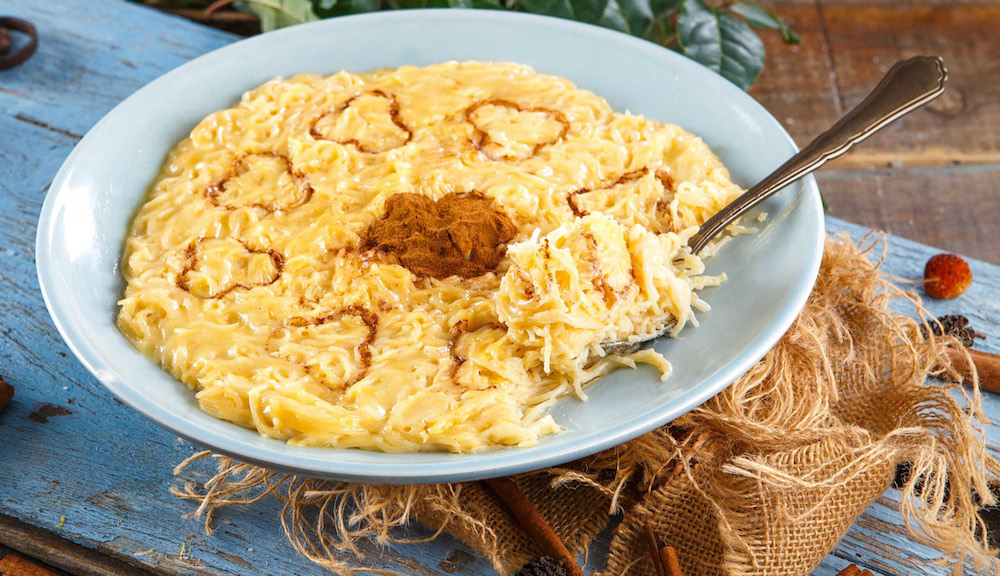
Aletria is one of the most typical Christmas desserts in Portugal and it comes from the Arabic classic iṭriyah, which simply refers to the thin noodles used to make this pudding. In Portuguese, aletria also literally refers to the vermicelli, which can be used in both sweet and savory preparations, but that has definitely been popularized with this dessert and thus becoming synonym with it. The first recipe of aletria dates back to the 8th century and can be found in the manuscript of O Llibre de Sent Soví, which consisted of a compilation of about 200 recipes.
As a dessert, aletria uses angel hair noodles cooked in an aromatic mixture of milk, sugar, egg yolks and flavorings such as cinnamon and lemon rind. This is the type of dessert that you rarely find in menus of Portuguese restaurants, but that is actually incredibly common at home, particularly during Christmas time.
Alconomias
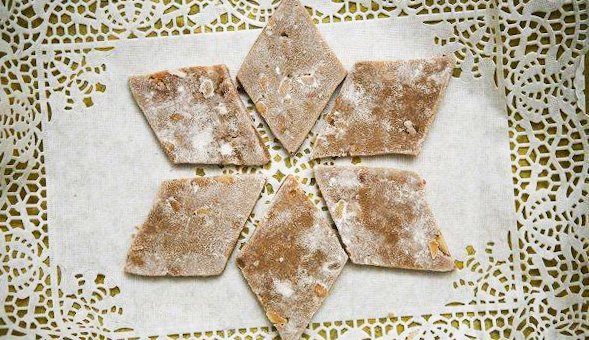
Based on their name, shape and the ingredients involved in the recipe, it’s easy to conclude that alconomias are an edible example of the Moorish inheritance in Portugal. This sweet typical of the Alentejo region is made with toasted wheat flour, honey and pine nuts, and it is shaped like a diamond. The name alconomia means cumin colored in Arabic, even though there is no cumin involved – the brownish color simply derives from toasting the flour.
Alconomias are not the type of Portuguese sweet that you will normally find in regular pastry shops. Instead, they are mostly sold during specific festivities and fairs, particularly during Saint Andrew, at the end of November.
Alfenim

Alfenim is a sweet made with sugar, water and vinegar, and an ancient recipe that was originally known in Arabic as al-fenid, meaning the white, the target.
Introduced into Portugal and Spain by the Moors, alfenim was eventually exported to Brazil by the Portuguese, and to Mexico by the Spanish. Before making it across the Atlantic, the Azores also received this sweet tradition, and it’s precisely in the Portuguese archipelago where you can still find alfenim these days: in the islands of Terceira and Graciosa the tradition is still alive. Here you’ll be able to see and taste truly interestly shaped alfenim, depicting flowers, animals and more, used for eating pleasure but also as religious offerings during the Holy Spirit festival.
The Arab influence in the way we eat today is not reduced to actual dishes. The wide use of certain spices and aromatics (like clove, saffron and coriander), ingredients (carob, almonds, figs, citrus fruits) and sweets (candied fruits, honey, syrups) wouldn’t be the same these days without their influence and trade. Beyond the main meals, the Moors were very fond of sweet dishes, which is something we can easily observe the Portuguese have had no problem keeping the legacy alive!
Can you think of more examples of Arabic-influenced foods in Portugal? Share them with us via Facebook or Instagram, and please tag us @tasteoflisboa #tasteoflisboa
We’ll love as well to see your photo shoots, to know about your insights, questions, suggestions and wishes on your food & culture experiences in Lisbon and Portugal. Please share with us via Facebook, Instagram or Twitter and tag us @tasteoflisboa or #tasteoflisboa.
Feed your curiosity on Portuguese food culture:
Travel around Portugal in 18 foods (without leaving Lisbon)
Foods you didn’t know were Portuguese
Real people, real food. Come with us to where the locals go.
Signup for our natively curated food & cultural experiences.
Follow us for more at Instagram, Twitter e Youtube
